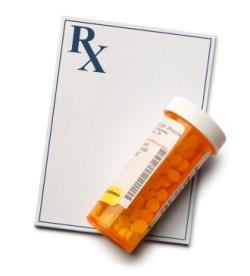Menstruation
 Menarche is the term used to indicate the onset of a girl's very first menstrual period. The female menstrual cycle is typically 28 days in length but can vary from 21 to 34 days in length and still be considered "normal." Menstruation itself lasts a couple of days to a week. Clinicians are often interested in the age of onset of menarche as in a minority of cases, menarche may occur unusually early or late. The average age of onset of menarche is 12 years but can range from 8 to 16 years of age. Researchers are particularly interested in menarche as the prevalence of depression and anxiety in females increases at this time. In addition, menstruation is an area of research as a subgroup of women will experience clinically meaningful mood changes in the week or two prior to onset of menstrual flow.
Menarche is the term used to indicate the onset of a girl's very first menstrual period. The female menstrual cycle is typically 28 days in length but can vary from 21 to 34 days in length and still be considered "normal." Menstruation itself lasts a couple of days to a week. Clinicians are often interested in the age of onset of menarche as in a minority of cases, menarche may occur unusually early or late. The average age of onset of menarche is 12 years but can range from 8 to 16 years of age. Researchers are particularly interested in menarche as the prevalence of depression and anxiety in females increases at this time. In addition, menstruation is an area of research as a subgroup of women will experience clinically meaningful mood changes in the week or two prior to onset of menstrual flow.
What is Premenstrual Syndrome?
When asked, the vast majority of women will report that they experience "premenstrual syndrome" (PMS). However, what most women mean is that they have some type of relatively mild physical or emotional symptom for several days around the time they get their period.
Psychological symptoms typically include:
- Irritability
- Mood swings
- Increased sensitivity
Physical symptoms typically include:
- Cramping
- Bloating
- Breast tenderness
- Weight gain
- Appetite changes/cravings
- Fatigue
- Head aches
- Body aches and pains
Clinicians and researchers debate whether having a symptom or symptoms that does/do not interfere with any aspect of daily life should be referred to as a "syndrome," particularly if these symptoms occur in the majority of women. The American College of Obstetrics and Gynecology, the specialty's national professional organization, developed the following criteria or guidelines for gynecologists, mid-wives and other women's health care providers to use when making the diagnosis of PMS. They are as follows:
A symptom or symptoms must be:
- present in the 5 days before the period for at least 3 menstrual cycles in a row
- end within 4 days after the period starts
- interfere with some normal activities
If you think you may have PMS, the best step to take is to keep a written record of your symptoms for 2-3 months. Then take this information to your doctor. Having a written diary of your symptoms will help your doctor decide whether you have PMS or some other condition. It is important to note whether you feel that your symptoms cause you distress or interfere in any aspect of your daily life, whether it be productivity at work, home or in your relationships with others.
What is Premenstrual Dysphoric Disorder?
 Approximately 5% of women experience premenstrual dysphoric disorder (PMDD), a condition that is more severe than premenstrual syndrome (PMS). Women who experience PMDD often experience emotional symptoms that are more moderate to severe than routine PMS. These emotional symptoms take place each month prior to the onset of menstruation. Some women may have symptoms that last 7-14 days, while others may find that their symptoms only interfere with daily activities for several days prior to menses. After several days of menstrual flow, women with PMDD feel as if they are back to their normal selves.
Approximately 5% of women experience premenstrual dysphoric disorder (PMDD), a condition that is more severe than premenstrual syndrome (PMS). Women who experience PMDD often experience emotional symptoms that are more moderate to severe than routine PMS. These emotional symptoms take place each month prior to the onset of menstruation. Some women may have symptoms that last 7-14 days, while others may find that their symptoms only interfere with daily activities for several days prior to menses. After several days of menstrual flow, women with PMDD feel as if they are back to their normal selves.
Women with PMDD may experience the following symptoms:
- Depression or hopelessness
- Decreased interest or pleasure in usual activities
- Anxiety
- Sadness or tearfulness
- Increased sensitivity
- Feeling overwhelmed
- Irritability
- Loss of energy
- Trouble sleeping or sleeping too much
In addition, women with PMDD may experience physical symptoms such as:
- Bloating
- Breast tenderness
- Appetite changes; cravings or increased eating
- Weight gain
- Fatigue
- Headaches
- Bodily aches and pains
- Cramps
In order to meet criteria for PMDD, a woman has to
- experience significant symptoms of either low mood or decreased interest or pleasure.
- have a total of 5 symptoms, either psychological or physical.
- have the symptoms present during the week prior to menses during most menstrual cycles in the previous year.
- have the symptoms stop before her period is over and not have the symptoms again until the 1 to 2 weeks prior to her next period.
- have symptoms that cause at least a moderate level of distress or interference in some aspect to daily life.
Treatment
What can I do?
Women who experience more mild symptoms each month may benefit from simple changes in their lifestyle. Exercise may reduce stress and help to improve both mood and physical symptoms. In addition, healthy eating habits, along with vitamin supplements, may also help alleviate some symptoms of PMS.
When should I contact my doctor?
You should contact your doctor whenever you have a concern about your health and well-being as they are likely to be the best person to advise you regarding diagnosis and treatment options for PMS or PMDD. While many women with mild to moderate symptoms of PMS may be helped by life-style changes, others with more severe symptoms or those who suffer from PMDD are likely to require medical and/or behavioral treatment in order to experience significant clinical improvement.
Some women benefit from the use of oral contraceptive pills. One type of pill, which contains a type of progestin called drosperinone, has been marketed as Yaz® (Berlex) and is approved by the Federal Drug Administration for the treatment of PMDD. Women who suffer from severe symptoms may require other types of treatment. Treatment can alleviate the intense psychological turmoil and distress caused by these symptoms each month.
Treatment Options
 Although exercise, proper nutrition, calcium, and other supplements such as vitamin B6 may help alleviate some of the milder symptoms of PMS that occur, research studies have shown that these strategies do not consistently alleviate the types of symptoms that occur with PMDD. Medications known as selective serotonin reuptake inhibitors (SSRIs) are the first-line treatment for PMDD in many countries. The FDA has approved several SSRIs including sertraline (Zoloft®), fluoxetine (Prozac®) and paroxetine (Paxil®) for the treatment of mood and physical symptoms associated with PMDD. The majority of women who take these medications for PMDD experience a meaningful decline in their symptoms. However, PMDD symptoms typically return after discontinuation of the medication. Thus, SSRI treatment is not a cure although it can greatly reduce distressing symptoms and improve overall functioning.
Although exercise, proper nutrition, calcium, and other supplements such as vitamin B6 may help alleviate some of the milder symptoms of PMS that occur, research studies have shown that these strategies do not consistently alleviate the types of symptoms that occur with PMDD. Medications known as selective serotonin reuptake inhibitors (SSRIs) are the first-line treatment for PMDD in many countries. The FDA has approved several SSRIs including sertraline (Zoloft®), fluoxetine (Prozac®) and paroxetine (Paxil®) for the treatment of mood and physical symptoms associated with PMDD. The majority of women who take these medications for PMDD experience a meaningful decline in their symptoms. However, PMDD symptoms typically return after discontinuation of the medication. Thus, SSRI treatment is not a cure although it can greatly reduce distressing symptoms and improve overall functioning.
Many women wonder whether oral contraceptive pills (OCPs) can be a treatment for PMDD as these medications keep women from ovulating. Most OCPs cause women to have an even amount of hormones throughout the weeks they take them. Although OCPs keep hormone levels even, they expose the woman to different kinds of estrogens and progestins, some of which may not mimic natural hormones produced by the ovaries. Some women with PMDD notice a worsening of their mood symptoms with OCPs or that the symptoms are present all month instead of just before their period. One type of OCP called Yaz® received FDA approval for the treatment of PMDD in 2008. Yaz is different from many other OCPs on the market because the progestin in Yaz is called drosperinone and it works in the body differently than the progestins in most other OCPs. Whether this is the reason that Yaz is effective in the treatment of PMDD and other OCPs are not, is still the topic of research.
Another type of treatment that effects a woman's ovarian hormone production and is effective in the treatment of PMDD is gonadotropin releasing hormone (GnRH) agonist. However, GnRH agonists frequently cause women to experience typical menopause symptoms such as hot flashes, night sweats and vaginal dryness as GnRH agonists dramatically reduce ovarian production of estrogen. However, for the young woman whose PMDD symptoms are not responsive to SSRI or Yaz treatment, the side effects and risks associated with GnRH agonist treatment may be offset by the potential benefits of symptom reduction and improved quality of life.
No matter what treatment one ultimately chooses, the important thing to remember is that women do not have to experience PMS and PMDD. These symptoms are not "just part of being a woman." If your symptoms prior to your period cause you distress or difficulties in your life, you can feel better. Both SSRIs and Yaz are effective, well-tolerated treatments. Make an appointment with your doctor, document your symptoms and bring your symptom diary to discuss with your doctor. If you live in the Philadelphia area, the Penn Center for Women's Behavioral Wellness has clinicians who are trained to evaluate your symptoms and discuss with you the various treatment options. If you meet criteria for one of our on-going research studies, you may qualify for free care, otherwise, customary charges will apply.
Back to Top
